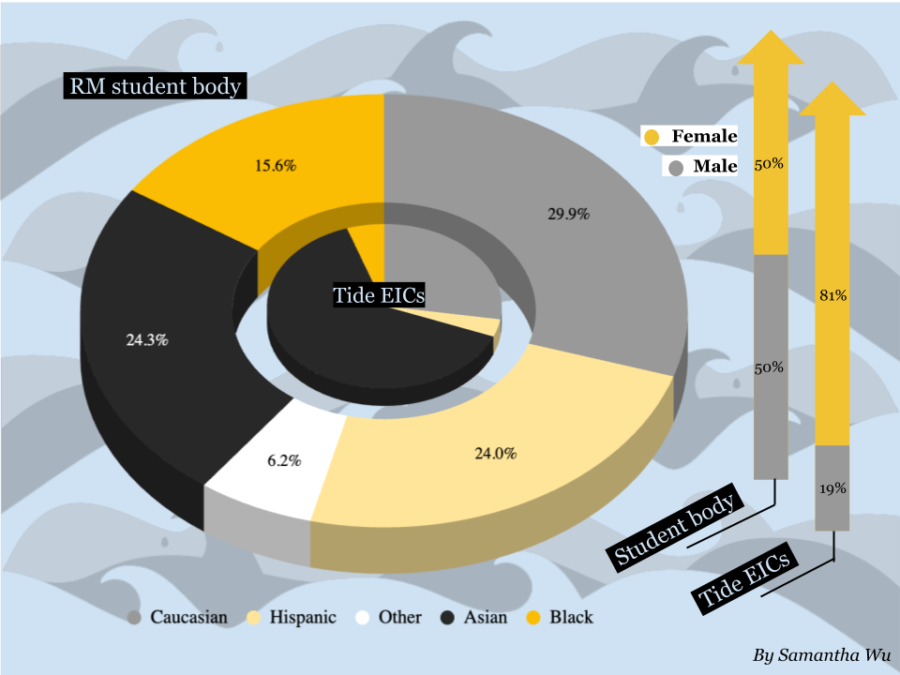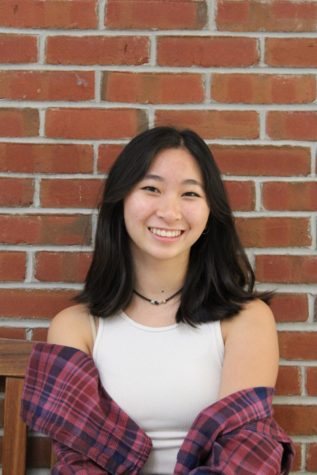The Tide’s staff must reflect the students it serves
The Tide’s editors-in-chief have not reflected the diversity of the student body.
May 11, 2023
Richard Montgomery is one of the most diverse high schools in the county, but The Tide’s newsroom composition fails to reflect this standing. The Tide not only strives to provide accurate, timely news to the student body but to represent perspectives. Although the paper has expanded its coverage capabilities through new Video and revived TidePod sections, the diversity of The Tide’s staff and representation of the student body’s greater perspectives is sorely lacking—especially in positions of leadership.
We strive for our journalists to report the unheard perspectives and hidden narratives in every story. Possessing contributors from a variety of backgrounds with unique sets of lived experiences ensures that our news coverage ventures beyond the obvious. If these issues remain unresolved, The Tide risks becoming a newspaper for an audience that mirrors its staff, instead of a newspaper covering the entirety of the RM student body and the greater Rockville community. The potential dangers of unconscious bias shaping stories could rise, as they may remain unchallenged without the view of individuals who have lived experiences on the issues they report.
As a way to consider the perspectives that shape our newspaper, we analyzed the identities of students who lead The Tide, and therefore have the largest sway over its mission and message: the editors in chief (EICs).
Since the 2008-2009 academic year, 58 students have held the position of editor in chief, averaging four editors in chief per year from 2008-2018, and three editors since the 2018-2019 school year. RM’s student gender distribution is roughly split evenly between female and male, according to a recent USNews report, but over the past 15 years, 81%—an overwhelming majority—of these editors in chief have been women. Only 11 EICs have been male, with the last male editor in chief being Derek Yao during the 2019-2020 school year.
According to the 2021-2022 School Profile, with 24% Hispanic students, 16 percent African American students, 24% Asian students; 30% White students; and 6% multiracial students, “RMHS mirrors the ethnic diversity of Montgomery County.” But The Tide’s EICs do not reflect the diversity of a school that is 71% minority (non-White) students.
Asian students are heavily overrepresented in cohorts of EICs. At least half of every group of EICs has been comprised of Asian students, who make up nearly two-thirds of the past 15 years of EICs, followed by Caucasian students at 27%. In comparison, other racial groups are severely underrepresented. Since 2008, just three Black and two Hispanic students have served as EIC, or just 5% and 3.4% of the 58 EICs respectively. This is despite the two racial groups accounting for a combined 40% of the student population, almost double the 24% Asian students makeup.
The social and cultural benefits of RM’s status as one of the most diverse schools in the country also imbues The Tide with the responsibility to portray and represent that diversity. Finding, investigating and telling diverse stories—and fulfilling our responsibilities as journalists—begins with having a staff that is more representative of the community we are serving.
A multimedia contributor who follows RM’s Black Student Union might capture the lively performances of African Diaspora Night through video, while another writer passionate about art might raise attention to arts program budget cuts, leading to coverage of declining class conditions. It is impossible for one person, or even three EICs, to find and pursue every story worth telling—no matter how immersed they are in the RM community. That’s why newsroom diversity is a catalyst for uncovering stories that don’t immediately present themselves.
As the diversity of The Tide expands, the diversity of stories recognized as “newsworthy” expands. A positive feedback loop begins to form: more relevant and poignant stories to our audience are published, so more readers connect with The Tide, in turn further diversifying our coverage and readership, bringing The Tide closer to a newspaper truly of the student population.
We must encourage and retain contributors from all interests and backgrounds, from writers to editors to graphic artists to podcast hosts. But that process starts with accessibility and visibility to a greater proportion of RM’s student population—with The Tide’s recruitment process each school year, and the experiences we provide as a newspaper leadership team to create an environment that inspires contributors to keep contributing.
The Tide is a more easily aligned opportunity for students with certain backgrounds and aspirations, leading to a bias in coverage. For example, rigorous practice schedules often pose an obstacle to student athletes joining The Tide, as they are less likely to have free time after school for other clubs, creating holes in Sports coverage. Students who prefer STEM over humanities are less likely to gravitate towards writing-based extracurriculars, making it more difficult to staff the Science beat. But The Tide offers students the chance to become involved at any commitment level, from taking a single photo every month to writing an article every two weeks.
We’d like to note that the majority white/Asian and female newsroom that sits writing and editing this piece is a product of accessibility to extracurricular writing opportunities across the school.
This year, we’ve been working to make The Tide easily accessible by incorporating scannable QR codes into kickoff presentations and posting flyers throughout the school. We’ve seen that effective advertising has real results. For the past two years, enrollment in RM’s journalism class only filled a single period. But following notices about the class in English classrooms across the school and in announcements on RMBC, enrollment doubled for this year’s classes—so much that it had to be split into two class periods. The spike in enrollees and staff writers is a much more accurate reflection of the gender distribution of RM.
With a continued focus on increased accessibility and visibility to attract student contributors with a wider range of lived experiences, The Tide’s staff and coverage will better live up to its name: the student newspaper of Richard Mongomery.




